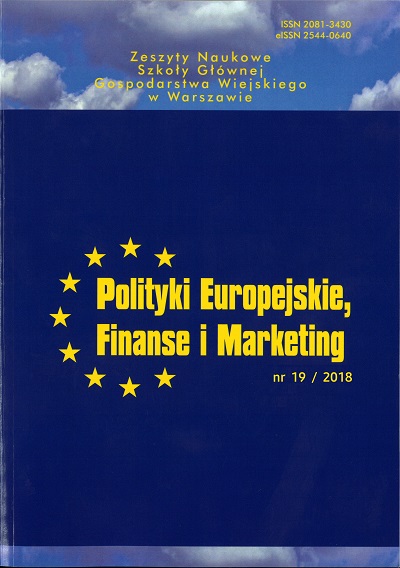Main Article Content
Article Details
Baumgarten C.: Chirping for Charity: How U.S. Nonprofit Organizations Are Using Twitter to Foster Dialogic Communication. "The Elon Journal of Undergraduate Research in Communications", 2, 2011.
Bortree D.S., Seltzer T.: Dialogic strategies and outcomes: an analysis of environmental advocacy groups' Facebook profiles. "Public Relations Review", 35, 2009. (Crossref)
Briones R. L., Kuch B., Fisher Liu B., Jin Y.: Keeping up with the digital age: How the American Red Cross uses social media to build relationship. "Public Relations Review", 37, 2011. (Crossref)
Carboni J.L., Maxwell S.P.: Effective Social Media Engagement for Nonprofits: What Matters? "Journal of Nonprofit and Public Affairs", 1, 2015. (Crossref)
Guidry J.D., Saxton G. D., Messner M.: Tweeting Charities Perceptions, Resources, and Effective Twitter Practices for the Nonprofit Sector [in:] Waters R.D., (ed.): Public Relations in the Nonprofit Sector, Routledge, NY 2015.
Lovejoy, K., Saxton G.D.: Information, Community, and Action: How Nonprofit OrganizationsUse Social Media. Journal of Computer Mediated Communication, 17 no. 3, 2012. (Crossref)
Lovejoy K., Waters R.D., Saxton G.D.: Engaging stakeholders through Twitter: How non-profit organizations are getting more out of 140 characters or less. "Public Relations Review", 38, 2012. (Crossref)
Messner M., Jin Y., Medina-Messner V., Meganck S., Quarforth S., Norton, S.: 140 characters for better health: An exploration of the Twitter engagement of leading nonprofit organizations [in:] Al-Deen H. N., Hendricks J. A. (ed.): Social media and strategic communications. Basingstoke, UK: Palgrave Macmillan 2013. (Crossref)
Ogden T., Starita L.: Social networking and mid-size nonprofits: What's the use? Philanthropy Action, 2009. http://www.philanthropyaction.com/articles/social_ networking_and_midsize_ nonprofits_whats_the_use (1-22)
Oliński M., Szamrowski P.: Znaczenie mediów społecznościowych w funkcjonowaniu organizacji pożytku publicznego, "Zeszyty Naukowe Organizacja i Zarządzanie Politechniki Śląskiej", 114, 2018. (w druku) (Crossref)
Urbaniak, G. C., & Plous, S.: Research Randomizer, 2013, (Version 4.0) [Computer software]. Retrieved on April 22, 2016, from http://www.randomizer.org/
Waters, R. D., Burnett, E., Lamm, A., & Lucas, J.: Engaging stakeholders through social networking: How nonprofit organizations are using Facebook. Public Relations Review, 35 (2), 2009. (Crossref)
Waters R. D., Jamal J. Y.: Tweet, tweet, tweet: A content analysis of nonprofit organizations' Twitter updates. "Public Relations Review", 37 (3), 2011. (Crossref)
Downloads
- Grażyna Michalczuk, Urszula Konarzewska, COMMUNICATION OF CSR ACRIVITIES IN THE PROCESS OF SOCIALLY RESPONSIBLE INVESTING , The Scientific Journal European Policies, Finance and Marketing: No. 19(68) (2018)
You may also start an advanced similarity search for this article.
- Adam Pawlewicz, Piotr Szamrowski, The Importance of Corporate Blogs in Business-Customer Communication , The Scientific Journal European Policies, Finance and Marketing: No. 9(58) (2013)
- Marian Oliński, Piotr Szamrowski, DIALOGIC FEATURES OF PUBLIC BENEFIT ORGANIZATIONS WEBSITES - RELATIONAL APPROACH , The Scientific Journal European Policies, Finance and Marketing: No. 16(65) (2016)

This work is licensed under a Creative Commons Attribution-NonCommercial 4.0 International License.
All articles published in European Policies, Finance and Marketing are fully open access. In this way, the scientific research results contained in articles published in our journal are available to every reader free of charge - in accordance with the CC BY-NC license (https://creativecommons.org/licenses/by-nc/4.0/).
According to the CC BY-NC license you are free to:
- Share — copy and redistribute the material in any medium or format
- Adapt — remix, transform, and build upon the material
The licensor cannot revoke these freedoms as long as you follow the license terms.
Under the following terms:
- Attribution — You must give appropriate credit , provide a link to the license, and indicate if changes were made . You may do so in any reasonable manner, but not in any way that suggests the licensor endorses you or your use.
- NonCommercial — You may not use the material for commercial purposes .
- No additional restrictions — You may not apply legal terms or technological measures that legally restrict others from doing anything the license permits.
Source: https://creativecommons.org/licenses/by-nc/4.0/deed.en
According to that, the authors retain the copyright and full publishing rights.





